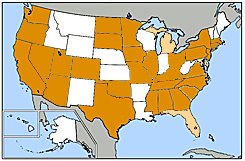Washington, DC

I’m enjoying this new journal that my cousin, Becky, gave me. Not only does it have a watercolor of Mt. Hood on the front, it also has blank pages! My previous journal, which had more of a Mediterranean faux leather cover, had rule-lined pages. I was a little worried that a lack of lines would lead to a lack of straightness of print, but it hasn’t been a problem for me. And would it really be a problem if my lines weren’t straight, anyway?
But the blank pages immediately appealed to my creative tendencies, and I started by drawing. Hopefully I’ll break free of the need to only write in order to reflect on my experiences.

On a related note, last night, while presenting some of my ideas at American University in DC, an education student asked me about structure. He said that he’s learning in his ed classes that students do best with lots of structure, but that my classroom as I described it didn’t seem all that structured. Here are my thoughts:
First of all, my class is actually quite structured, but it’s a more casual, fun structure, and students help develop it. We have actually developed detailed procedures for turning in work, cleaning up, working in groups, what to do when you’re absent, etc. (all the stuff Harry Wong so effectively promotes in his book.)

But clean-up time, for instance, is signaled not by my voice or a noise-maker, it’s Barney’s clean up song (with a fitting plot twist for the annoying dinosaur.) Students groove around, cleaning up, and are back to their assigned seats by the end of the song. It’s highly structured, but it’s groovy structure. Having high expectations and an orderly class that benefits students needing structure doesn’t necessitate a strict teacher, or students who work quietly in their seats.
In the same way, stability in a home doesn’t necessarily mean financial stability, or staying in the same house without moving. Stability can (and should) be built on the relationships within the home, however temporal the location or shaky the income. The same holds true in a classroom: true structure and stability can only arise from the relationships therein. Since these relationships are between human beings, we need to treat each other as such, and not as mechanistic drones that need to do everything in a mundane or traditional way.
Which brings me my second point: human beings actually crave novelty. This is obvious from observation, and neuroscience backs it up. Engagement and learning occur from novel situations, and we need to provide these situations as often as possible for our students. Kids generally aren’t quite sure what might happen on a given day in our science classroom (sometimes I’m not sure where things might go, either!), and that’s a good thing.
Not only does it help kids get excited about coming to class, it actually helps them learn. For students who need lots of structure, make sure it’s there at a fundamental level, but never allow it to become too routine. That’s when boredom sets in, and learning for most students (especially "at-risk" students) ends.
The blank pages of my journal actually have quite a bit of structure, and I would argue that they are fairly limited and don’t actually present me with the possibility for truly novel reflection. They are only 6”x9”, two-dimensional, and bound into a book. I can overcome these boundaries, and try to do so with the more freeform structure of the web, my short films, and in the interactions I have with other people. I have yet to start tearing pages out of the journal to make an origami piece, but perhaps it’s a future possibility!
Structure is not synonymous with routine, drudgery, or strict authority. It can exist in the same time and place as novelty. The human brain needs both, and it’s our job to facilitate that balance.









novelty, yes! very well said. apparently it is a magic journal.
ReplyDeleteWe were just watching a video today of a brain guy named Dr. Spencer Kagan who was talking about how the human brain craves novelty. Like when you enter a room and hear the hum of the refrigerator, but then 5 minutes later you don't hear it. It doesn't help your survival to notice it anymore. Same with smells (like when we moved in next to this blasted dairy!) Our brains just tune it out and seek something new to focus on.
ReplyDeleteAs teachers, we don't want to become just the hum of the fridge to our students. Or worse yet, a foul odor.
I would love to add this post as is (wiht identifying info, of course) to a blog we keep for new teachers at my school (http://chetscreek.blogspot.com). You put it so nicely so teachers understand that fun and engaged doesn't mean loosey goosey and strong rituals and routines doesn't translate boring! Thanks for a great post!
ReplyDeletedayle timmons
2004 Florida Teacher of the Year
timmonsd@duvalschools.org
Sure, Dayle, not a problem at all. You could either just link the post, or copy and paste. Thanks for asking.
ReplyDelete